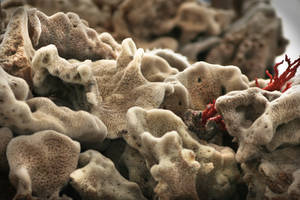Healing Fractures with Sea Sponge
Interview with
Professor Ming Hao Zheng from the University of Western Australia is leading a  research project that began with a walk on the beach, when he kicked a dried up piece of sea sponge.
research project that began with a walk on the beach, when he kicked a dried up piece of sea sponge.
He immediately noticed how much its porous structure looked like human bone. And he's now created sea sponge implants to treat osteoporosis that are now undergoing animal trials, as he explained to Victoria Gill.
Ming - This sea sponge powder once implanted into a pouch of muscle, we can see on the inside of the muscle, they induce the sea sponge to become bone tissues. So, that tells us that these sea sponge have osteo conductivity to actually attract stem cells to form bone tissues.
Victoria - So, it's actually forming bone tissue in the animal's body that would never grow bone.
Ming - Exactly, yeah. So, that is what we can use because this scientific experiment proved that this sea sponge may be able to use in patient for the induction of bone formations.
Victoria - We're looking now at a piece of the sea sponge and this is actually the same species that you kicked upon the beach in Margaret River. So, what did you notice about it that inspired your research?
Ming - The first thing I noticed about this - what I kicked away was probably a piece of animal bone that's left by dog, but after I look at it, no, this is sea sponge. So I said, "How come the sea sponge look like animals bone?" But the more I look at it, this is not animal bone. It's a sea sponge. So, I analysed them and found that the sea sponge first of all, their morphology is almost identical to the normal bone tissue and secondly, when we analysed this, the sea sponge contained collagen. We found that collagen is very conservative though evolution. So, in other words, what we're seeing of collagen in a sea sponge is probably very much identical from the collagen like we see in humans. So, as a result, this inspired me that the sea sponge may be bio-comparable, maybe about to be implanted into the human tissue.
Victoria - And it's this very porous structure that you can see these tiny little holes in it that made you think of that bone scaffold, is it?
Ming - Yeah. There are all these tiny holes and all these holes are connected to each other. It's very much like what we see in human bone tissues.
Victoria - You've brought some of the paste along. So, in this dish here, what do we have?
Ming - So, we took the sea sponge and processing in the lab and make this become a sea sponge paste. We now do this paste implant into an animal to examine osteo conductivity. Some of the study found that this sea sponge paste can induce bone formations in the muscles.
Victoria - Osteo conductivity, so that means, causing bone to grow, inducing bone to grow.
Ming - Yeah.
Victoria - So, it looks a little bit like wallpaper paste. It's peach and it sort of has these fine granules in it. It's got a rather sort of sticky kind of claggy consistency. What exactly is in there?
Ming - Well, what we do is that we process this. The key is to actually remove all the DNA in the cells from the sea sponge and then we just preserve the collagen component and some of the mineral components. And then we mix with some of the chemicals to actually make a paste-like structure that we can make a different shape according to the shape of the bone and then do the implant.
Victoria - The implant could be shaped for the fracture, for the damage, for the specific bone that you're using it for.
Ming - Yeah. Sometimes we can put it in as a strip or in some solid bone or we can make it injectable.
Victoria - So, from a simple walk on the beach to this, which could be used in human clinical trials within - how long do you think before this comes into the clinic?
Ming - At the moment, the key is that we have to finalise a so-called agriculture good manufacture practice to ensure that the starting material of sea sponge is not sea sponge they can pick up from the beach. It's actually a sea sponge that goes through a quality control production and then we can use in the patient and this is why it's holding me for so long, but I hope in the next 2 or so years. With potential partner, we're able to translate this idea into patient use.
Victoria - So, you'll get your steady supply of sea sponge and then hopefully, get this into the clinic, and it will be able to help heal some very problematic fractures.
Ming - Absolutely.
- Previous Cells Between Life and Death
- Next Muscular Dystrophy Treatment










Comments
Add a comment